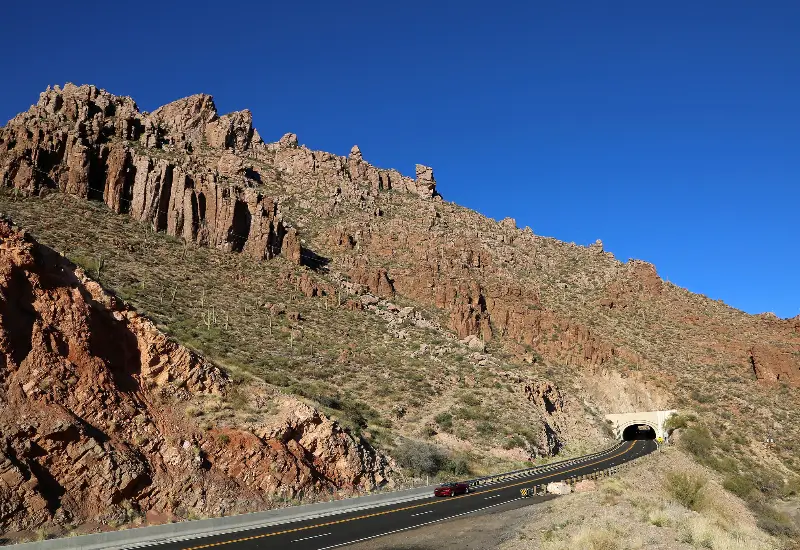Arizona’s tunnels are vital pathways for millions of travelers and commercial vehicles. Their safety is critical to the state’s infrastructure. Fires within these confined spaces present unique and serious dangers. Specialized fire protection is crucial for effectively managing these risks. Service 1st Fire Protection can help you understand the importance of fire protection systems for tunnels as well as Arizona’s specific regulations. We’ll cover design considerations for the local climate and the necessity of proper maintenance from certified experts. Understanding these elements is key to ensuring safety and tunnel integrity.

The Unique Dangers of Tunnel Fires
Fires in tunnels behave differently from those in open spaces. The enclosed environment causes heat, smoke, and toxic gases to build up rapidly. This creates a perilous situation for anyone inside. The intense heat can also weaken the tunnel’s structure, leading to potential collapse. For first responders, these conditions are incredibly challenging and hazardous. A tunnel fire can shut down major transportation routes for extended periods, causing significant disruption to regional traffic flow and commerce. Quick detection and suppression are vital to protect human life and maintain the integrity of our infrastructure.
Essential Types of Tunnel Fire Protection
Tunnels need strong defenses against fire. Different systems work together to keep everyone safe inside. They help fight fires and protect the structure itself from damage. Typical fire suppression mechanisms include:
- Deluge Systems: These systems release a lot of water fast. They quickly put out fires and cool down hot areas to prevent further spread.
- Water Mist Systems: Fine water droplets absorb heat. This smothers flames and removes oxygen, making the fire unable to burn.
- Detection Systems: Sensors find fires quickly. Heat, smoke, and flame detectors send early warnings to alert everyone and start safety procedures.
- Ventilation Controls: These systems manage smoke. They keep escape paths clear for people and help firefighters reach the fire safely.
Arizona’s Regulatory Landscape for Safety
Arizona has specific state and local codes that govern fire protection systems for tunnels. These regulations ensure that all public infrastructure meets strict safety standards. The National Fire Protection Association (NFPA) provides key guidelines, particularly NFPA 502, the Standard for Road Tunnels, Bridges, and Other Limited Access Highways. This standard outlines requirements for the design, installation, and maintenance of fire protection systems for tunnels. Strict compliance with these codes is mandatory. It protects public safety and reduces liability for tunnel operators. Regular updates and adherence to these rules are essential for maintaining a safe transportation network.
Designing a System for Arizona’s Climate
Arizona’s desert climate presents unique challenges for fire protection equipment. Extreme heat and arid conditions can affect system components and their long-term reliability. System design must account for rapid temperature fluctuations to prevent damage or malfunction. Material selection is also critical. Components must be able to withstand the harsh environment without degrading. Professional engineering is necessary to create a system tailored to each tunnel’s specific structure, use, and environmental exposure. This ensures that the fire protection measures will perform as expected during an emergency, providing reliable safety for everyone.
The Role of Inspection, Testing, and Maintenance
Maintaining tunnel fire protection systems is critical. Consistent inspection, testing, and maintenance (ITM) ensure every component works correctly in an emergency. This regular upkeep keeps systems reliable and ready:
- Pumps and Valves: Check these components for proper operation. Confirm they can deliver water or fire suppressants effectively.
- Detectors and Panels: Verify fire detectors respond accurately. Ensure control panels can activate and manage the system.
- Certified Professionals: Have trained experts perform all maintenance tasks. This ensures compliance with safety codes and standards.
- System Readiness: Regular ITM guarantees the system performs when needed most. It protects your investment in safety technology.
Integrating Advanced Fire Technologies
Modern advancements are making fire protection more effective. Smart systems can now integrate with traffic control and emergency communication networks. This integration allows for a faster, more coordinated response during a fire. For example, the system can automatically alert traffic management to stop vehicles from entering the tunnel and simultaneously notify emergency services. These technologies provide greater control over the situation, helping to manage smoke, guide evacuations, and give firefighters real-time information. Investing in these advanced fire protection systems for tunnels leads to faster response times and better outcomes in emergencies.
Frequently Asked Questions (FAQs)
Fire protection systems are critical for businesses and homes in Arizona. When it comes to making the most of yours, we have you covered with some of our frequently asked questions, including:
- How often should tunnel fire systems be inspected in Arizona? According to NFPA standards and local Arizona codes, tunnel fire protection systems require regular inspections. The frequency can vary depending on the system type, but comprehensive checks are typically required quarterly and annually.
- What’s the most effective fire system for a vehicle tunnel? The most effective system is often a combination of technologies. This usually includes rapid heat and flame detection, a deluge or water mist suppression system, and a robust smoke control and ventilation system.
- Who is responsible for ensuring fire systems in public tunnels are maintained? The government agency or authority that owns and operates the tunnel is responsible for ensuring all fire systems are properly maintained, inspected, and tested according to all applicable codes and standards.
Partner With the Experts for a Safer Journey Today
Specialized and well-maintained fire protection systems are essential for the safety of Arizona’s tunnels. From initial design to regular maintenance, every step is crucial for protecting lives and infrastructure. Ensuring these systems are compliant and fully functional requires professional expertise. Ensure your fire protection systems for tunnels are secure. Contact Service 1st Fire Protection today.